THE day for Horror. I hope to see Midnight Meat Train tomorrow and hopefully post about it soon. :)
Watch out for monsters!
-DR
Friday, October 31, 2008
Tuesday, October 28, 2008
Richmond Zombie Walk!
The Zombie Walk was amazing. Over two hundred people showed up, and we shambled and growled through the streets of Carytown and made quite a ruckus. Photos from here and here. Sadly, all of my own photos are trapped on my cell-phone.
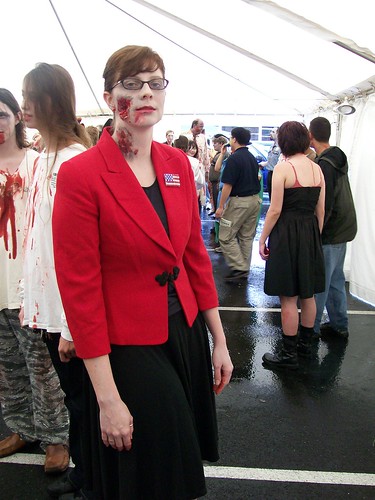
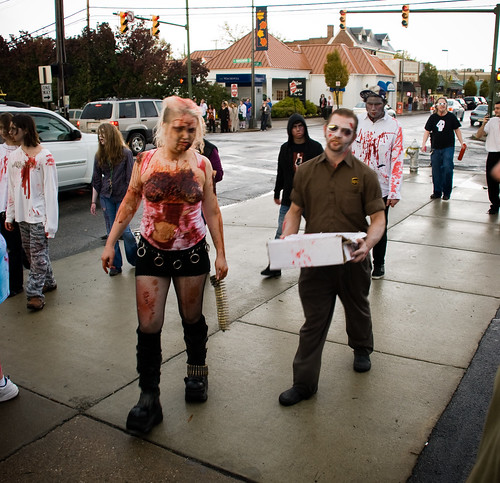

Snarlin' for the camera. I did both Dominik's and my own makeup. I really wish I could get a close up of Dominik's, I think I did a good job on his. He had little flecks of green, like his body had been left in the woods.

Sarah Palin Zombie!

Really good gore effects.

Snarlin' for the camera. I did both Dominik's and my own makeup. I really wish I could get a close up of Dominik's, I think I did a good job on his. He had little flecks of green, like his body had been left in the woods.
Friday, October 24, 2008
Bird Flu Vaccine Study
A Bird Flu vaccine study?
This is totally code for injecting people with unproven cures, then rubbing sick birds on them and recording the results. If fast, infected-style zombie break out in Seattle, you'll know why.
This is totally code for injecting people with unproven cures, then rubbing sick birds on them and recording the results. If fast, infected-style zombie break out in Seattle, you'll know why.
Masters of Horror: Imprint (2006)

Imprint was made for the series "Masters of Horror," and aired as episode thirteen of the first season. It was directed by Takashi Miike of Audition(1999), and features Youki Kudoh, Michie Itô, and Billy Drago.
The Masters of Horror opening reminded me of a Gothed-out Nip/Tuck trailer with all the Photoshopped moving gargoyles and bleeding doll eyes and such. I felt like it was trying too hard to impress.
Really, if the director wants a movie to be truly lifelike, he or she should really dispense with most CGI work. I feel that most CGI effects end up falling into the Uncanny Valley. The effects are just real enough that the viewer's mind that the unrealistic bits seem more jarring by comparison, and ruin the effect overall. This idea is more closely associated with robotics, but I think it applies here just as well.
After the Masters of Horror opening, and up until about half-way in, I wasn't enthused. The first thirty minutes play like a high budget SciFi channel movie. This is especially bad because it it essentially the low budget that makes SciFi movies entertaining.
I almost turned it off, despite the cinematography, which was absolutely stunning. Everything is saturated in rich rainbow color, even during scenes of torture. The costumes were amazing.
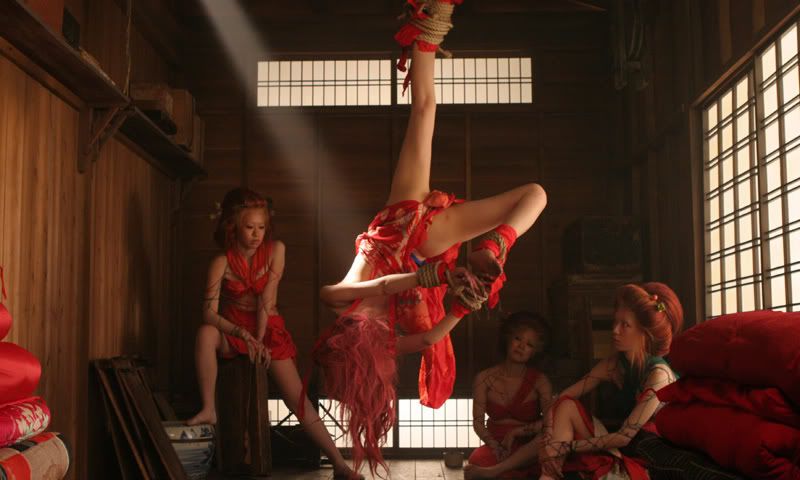
However, beauty doesn't make up for bad scripts. Seriously. This movie is set in Nineteenth Century Japan, and everyone talks like characters in a teenage Lifetime movie. Even aside from a certain lack of originality in dialog, people in Japan a hundred years ago would not be using English proverbs like "Keep your chin up." I am sure there's a Japanese equivalent that would have meant the same thing but not sounded so out of place.
In addition, the script really didn't do the idea behind the movie justice. Miike really plays with the idea of narration, of what makes a story "true" or believable. He leads the viewer deeper and deeper into the story of Komomo's death, showing each scene in the scarred woman's story change as the facts behind it shift.

The story begins basically as a set of cliches, with a man returning to rescue the beautiful hooker-with-a-heart-of-gold and take her home with him to America. Though Kokomo is not at that geisha house, he is forced to stay the night and hires a geisha who keeps to the back of what looks like a jail cell the girls are kept in. Her face is scarred on the right side, the skin stretched oddly, giving her a permanent lopsided smile. She informs Christopher that Kokomo killed herself a few months before, as she believed Christopher to have abandoned her.
Christopher refuses to believe her, prying for more details. As he questions, her story expands and changes. The scarred woman herself transforms along with the shifts, going from noble hero to betrayer to monster. I don't want to give too much away, but in the end, the viewer is left in suspense as to what truly occurred, and left questioning who, exactly, is the monster.
Theory: A
Execution: C+
Labels:
bad script,
CGI,
Japanese horror,
mystery,
narrative layers
Tuesday, October 21, 2008
Dead Alive (1992)

Dead Alive, also known as Braindead, was released by Peter Jackson and stars Timothy Balme and Diana Peñalver.
First of all, this movie blew The Lord of the Rings (2001) right out of my head. This is what Peter Jackson should be known for, not hobbits tromping around New Zealand, no offense to the LoTR fans. There were literally buckets of blood sloshing over everything. It was like the hallway scene in The Shining (1980), but with chunks. Simply awe-inspiring amounts of gore.
The only problem I had was at the end. When Lionel and Paquita, the heroes of this fine piece of cinema, kiss in the end scene, they are absolutely covered in what must be at least a dozen zombies' worth of goo, but they don't even wipe their lips. Things like that bother me in movies.
However, that scene is the least of the disgusting things contained within this film. I have a pretty strong stomach, and I still had some trouble at times eating my cheese and crackers. I threw all my limbs in the air with disgust many times throughout the movie, but I tell you, I never took my eyes off the screen.
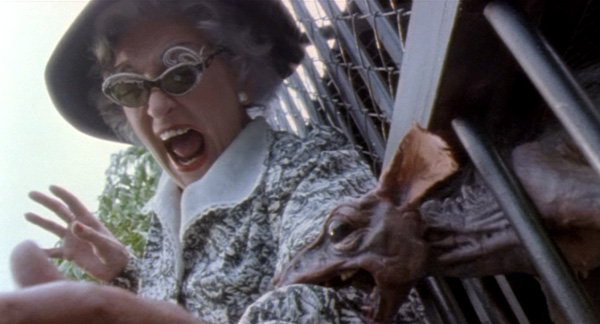
However, there was never a scene that felt smug. Watching, say, Hostel, (2005) one feels as if the film-maker is sitting back, smirking to him or her self and thinking, "Those smucks won't be able to handle this." In contrast, Dead Alive seemed gleeful in its treatment of the disgusting.
Every way that a person could possibly be killed is shown in amazing, over-the-top detail. It's intended to be gross, but any torture it intends to bring upon the viewer seems entirely good-natured. The message of the movie is basically, "Gross! Dude, come look at this!" and that is exactly what makes it enjoyable.

Dead Alive is high camp of the first order! A+
Zombie Walk!
Just thought I'd post some of these amazing pictures from Toronto's Zombie Walk. People went all out, and it really shows. Here's a few of my favorites:
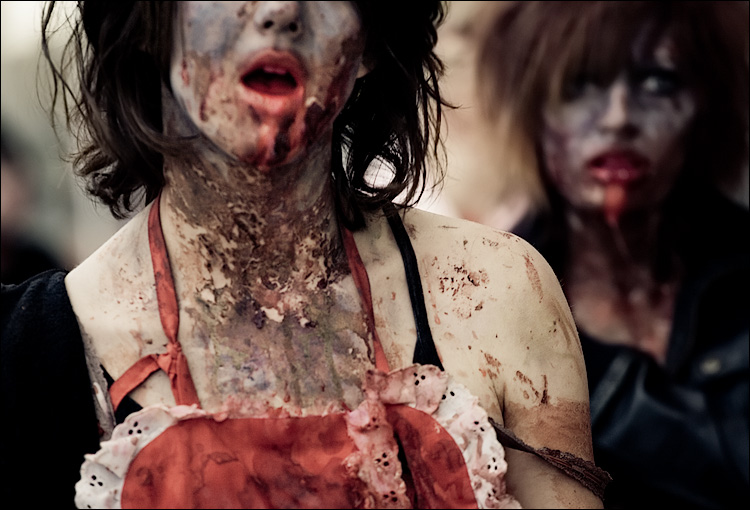
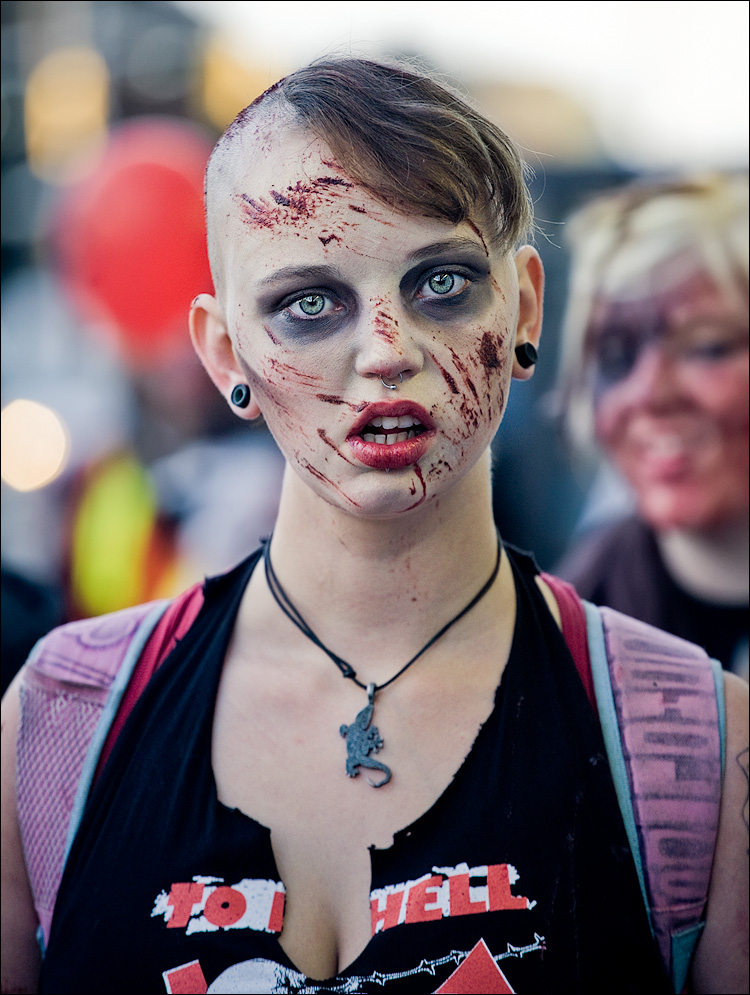
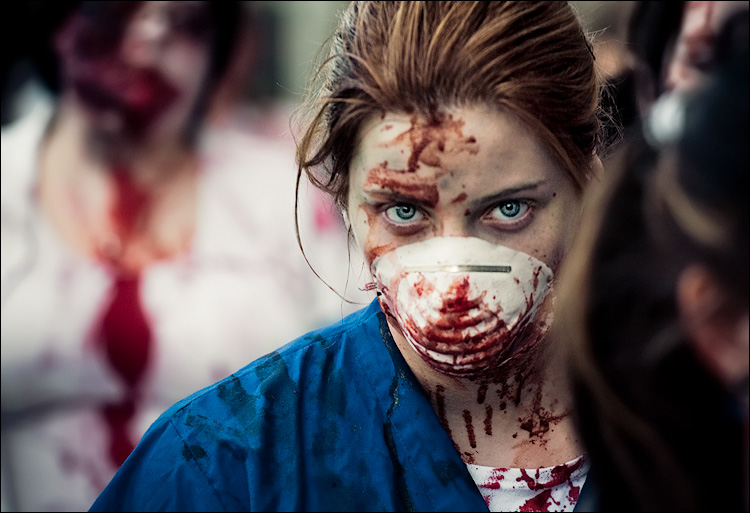 Pictures from this site.
Pictures from this site.
If you'd like to participate in a Zombie Walk, here's the site to see if there's one in your area. There'll be one in Richmond on Saturday and you can bet your brains I'll be there.
If you'd like to participate in a Zombie Walk, here's the site to see if there's one in your area. There'll be one in Richmond on Saturday and you can bet your brains I'll be there.
Saturday, October 18, 2008
Quarantine (2008)
 Quarantine was directed by John Erick Dowdle, and stars Jennifer Carpenter and Steve Harris. It is now in theaters.
Quarantine was directed by John Erick Dowdle, and stars Jennifer Carpenter and Steve Harris. It is now in theaters.Okay, I know a lot of people were angry that the trailer showed the end scene of the movie, which I agree was a stupid move on the part of Andale Pictures, but to me, the fact that the trailer AND the poster state "The residents were never seen again" gives more away. The inclusion of that sentence contextualizes the movie as just another "found footage" film, putting it up against Cannibal Holocaust,(1980) the horrible little movie that invented the genre, The Blair Witch Project (1999) and Cloverfield (2007), all of which could be said to have more going for them.
Without the trailer and poster, Quarantine stands up much better against the competition. The point-blank explanation of the cover-up given in the trailer dehumanizes the terror of the people trapped in the building. I finished the movie feeling spooked, but then I looked up the poster and it made me say "Meh" and basically forget everything I had just enjoyed about the film. The image, which is taken from the last minutes of the movie as well, makes the movie seem generic and derivative. It is practically interchangeable with the poster from Pulse(2006).

This is not to say that the plot isn't derivative. It absolutely is. Quarantine is a remake, specifically one that was put into production before the original, [REC] (2007) was even released. As a result, there's no way this movie wouldn't suffer somewhat. The thing that saved it, however, was the acting, which is something that can rarely be said about a horror movie.
This is evident in one of the last scenes, in which Angela, the reporter, and Scott, her camera man, are the last two people left uninfected. They enter a dark room for a reason I'm not too clear on. Angela is wailing and crying, and she keeps repeating "Keep the light on me!" to Scott, whose camera has a lamp attached to the front. To me, this captures perfectly the irrationality of terror. The light won't save her. In fact, it will probably attract more infected to her, but her human need for illumination, for vision and for the clarity she instinctively feels vision will bring her, is too strong. She descends into gibbering fear in a realistic way, without going over the top, and it really is the strength of the movie.
Scott has a similar moment after he beats an infected person to death with the camera. This not only makes for a really cool scene, but the few seconds shot with the lens spattered with blood are harrowing. Scott has a Lady Macbeth moment, with the camera trained on his face as he obsessively wipes off the blood long after it is gone. This is his only real screen time, but he certainly makes the most of it.

The movie also got me thinking about the new "fast" breed of zombie that has been so popular since the release of 28 Days Later (2002). I think their rise in popularity is not only due to the fast zombies' increased virulence as villains versus traditional shambling zombies, but to changes in what we fear as a culture. This fast zombie is never a dead person risen from the grave, but someone infected with a rage virus (28 Days Later), a mutation of rabies (Quarantine), or something similar. Even I Am Legend, (2007) which was based on a book about vampires, was transmuted into a movie about zombies caused by a faulty cure for cancer.
I've heard theories that zombies are a personification of people's fear of meaninglessness, but I think a greater, less existential fear has taken over: the fear of science. This is similar to the proliferation of nuclear mutation films in the 1950s. With all the current talk of pandemics and biological warfare, disease is in the front of everyone's mind, and corruption of the body is one of the most personal and intense fears a person can have. What is the fear of death if not a fear of betrayal by one's body, of pain? Combine this with a distrust of government and you get Quarantine.
Acting: A
Movie: B
Marketing: C-
Labels:
context,
fast zombie,
found footage film,
infected,
poster,
science,
trailer,
zombie
Hatchet (2006)

Hatchet came out in 2006, was written and directed by Adam Green and stars Joel Moore, Tamara Feldman,and Deon Richmond, along with a supporting role from Mercedes McNab, or Harmony from Buffy!
First of all, holy cheese on a cracker. I just had to get that out there. If you want some fantastic, no-cut-aways gore, watch this movie. Seriously. There was no cutting away to the shadows on the wall, and the effects were creative and well done. I really wish I could have seen it in theaters, or in HD or something. Whoa.
Now that I'm finished gore-geeking out, on to the review. This movie is billed as a Horror Comedy, and it manages to fulfill the requirements of both genres in a way that is quite satisfying. It is what I think so many Horror Comedies fail to be, which is funny but still frightening.
Behind the Mask: The Rise of Leslie Vernon (2006) manages both, but even Shawn of the Dead, (2004) which is often cited as people's favorite Horror Comedy, fails in this respect. A zombie friend one keeps chained up to play video games with is funny, but all the bite, so to speak, of the zombie threat is neutralized. Needless to say, Hatchet does not end on such a light-hearted note.
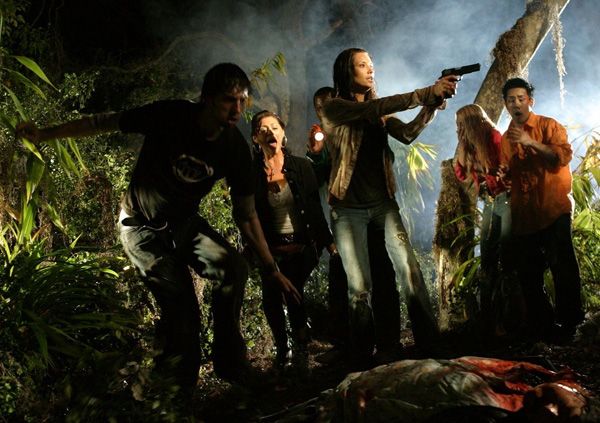
The scene I found the most interesting on an intellectual level involves two older, Midwestern tourists who are dispatched early on. Everyone is stranded in the bayou near the house of Victor Crowley, and the only way out of the swamp is to pass this haunted, murderous house. The husband, Jim, has been injured by a crocodile, and Ben and Marcus, the College guys in New Orleans for Mardi Gras, are helping him to walk. Once they find out the house is haunted, they immediately abandon the older man. His wife, Shannon, takes him on her own shoulder, leading him towards the road and the house. As she walks with him, she says "Everything's going to be just fine... We have the Good Lord with us, baby. The Good Lord will protect us." Of course they are both immediately and gruesomely killed.
The fact that Shannon utters those lines moments before her death is quite significant. In horror, no matter the medium, the true terror lies in the fact that no one, not even God, can save you. There is no escape. Belief is, in fact, often the way deeper into trouble. Take Bug, (2006) with Ashley Judd, or Kate Hudson in Skeleton Key (2005). These examples don't necessarily deal with religion, exactly, but they show the downsides of belief in a way not usually seen in the media, that faith in the wrong thing can hurt just as much as positive faith can heal. I think this illustrates what the true purpose of Horror movies is: not only as a catharsis, a release of all the negativity inherent in the human psyche, but as a outlet for ideas that, though valid, are considered unacceptable in society.
One last thing: The tag line to this movie is ridiculous:
"It's not a remake. It's not a sequel. And it's not based on a Japanese one. HATCHET: Old School American Horror." A Japanese what? I mean, I know the meaning is inferred, but that just sounds bad syntactically. Come on, people. Also, a movie based on an earlier Japanese film would be a remake as well, so that's redundant.
Movie: A
Syntax: D-
Friday, October 17, 2008
Sleepaway Camp (1983)
 I thought I'd start off with something considered a classic, but not something too well known. (Spoiler Alert, btw).
I thought I'd start off with something considered a classic, but not something too well known. (Spoiler Alert, btw).Sleepaway Camp was written and directed by Robert Hiltzik, starring Felissa Rose and Jonathan Tiersten. (http://www.imdb.com/title/tt0086320/)
First of all, I like slasher movies. They just rock, despite the many problems inherent in the genre, and this one is a perfect example. The politics behind this movie made it hard for me to enjoy in retrospect, though I was riveted while it was on-screen.
I can't deny that some of the kills were effective, even if they seem a bit old-school now. I mean, getting scalded while trying to boil corn is a bit less impressive than the gore of the torture-porn genre. However, what made these kills frightening was that they left something to the imagination. There was a lot of shadow work and shots of grasping hands, with a few well-done shots of the dead body thrown in as well. Much of the kill is not actually shown on-screen.
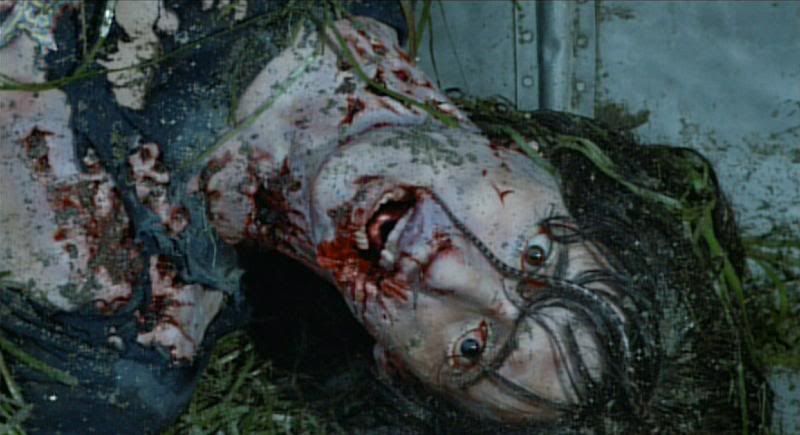 This means that, rather than squirming away from something that is graphically depicted, the viewer's mind has to fill in the gaps, which is always so much worse, or better if one prefers. The viewer didn't have to physically see Judy, the camp mean girl, get violated with a curling iron, the shadow on the wall was enough.
This means that, rather than squirming away from something that is graphically depicted, the viewer's mind has to fill in the gaps, which is always so much worse, or better if one prefers. The viewer didn't have to physically see Judy, the camp mean girl, get violated with a curling iron, the shadow on the wall was enough.Judy's death, to me, sums up her status in the movie. It is a symbol of femininity, a curling iron, that kills her. Overall, she exists only to be the Whore in contrast to Angela, the almost-mute new camper's, initial status as Virgin. When she first really attacks Angela in the cabin they share, she focuses on her body. She asks why Angela showers alone, and speculates as to if she's reached puberty yet. To Judy, this is the most insulting thing she can say to Angela. Judy's status at the camp focuses directly around her body, as do all the girls'. Angela's failure to fit into their concept of girlhood enrages them. Most of Judy's interactions with Angela consist mainly of Judy screaming into Angela's passive face, though this may just be a result of bad acting.

The "twist" ending held just as much gender bias. Angela is reveled as being male, and the killer to boot. The end scene, especially Angela's bug-eyed expression, is creepy, but the underlying morals are creepier. Angela's true crime is not conforming to society's gender roles.
Her motivation for killing is apparently not the horrible accident that killed her father and brother, which was caused by careless campers, but instead being raised as a girl by her aunt, who it seems was transgendered and preferred to have a girl child. This experience, though it would be confusing to a child in real life, is positioned as so inherently traumatic as to turn someone into a psycho killer.
It also seems that the end shot provided the genesis of all the J-Horror screaming ghost children, as Angela could easily be transported into The Grudge during this shot. If this is good or bad, that's personal preference.
Overall:
The Film Itself: B
The Film's Politics: D-
Cruel Intentions
As a first post, I'd thought I'd lay out my intentions.
I've watched an egregiously large number of horror movies in the past year. More than I should admit, really, and I know this compulsion isn't going anywhere. As a dorky English major who wants to be a horror writer, I find myself analyzing everything I watch, and I thought I'd write some of it down. It'll be a mix of classic, not-so-classic and new movies, with some books and other media thrown in.
Also, HERE BE SPOILERS! Watch out!
I've watched an egregiously large number of horror movies in the past year. More than I should admit, really, and I know this compulsion isn't going anywhere. As a dorky English major who wants to be a horror writer, I find myself analyzing everything I watch, and I thought I'd write some of it down. It'll be a mix of classic, not-so-classic and new movies, with some books and other media thrown in.
Also, HERE BE SPOILERS! Watch out!
Subscribe to:
Posts (Atom)


